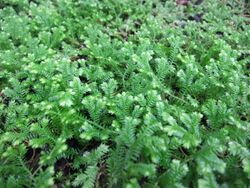Biology:Selaginella kraussiana
| Selaginella kraussiana | |
|---|---|

| |
| Scientific classification | |
| Kingdom: | Plantae |
| Clade: | Tracheophytes |
| Clade: | Lycophytes |
| Class: | Lycopodiopsida |
| Order: | Selaginellales |
| Family: | Selaginellaceae |
| Genus: | Selaginella |
| Species: | S. kraussiana
|
| Binomial name | |
| Selaginella kraussiana (Kunze) A. Braun[1]
| |
| Synonyms[2] | |
|
Selaginella azorica G.Nicholson | |
Selaginella kraussiana is a species of vascular plant in the family Selaginellaceae.[2] It is referred to by the common names Krauss' spikemoss,[3] Krauss's clubmoss,[4] or African clubmoss, and is found naturally in parts of Sub-Saharan Africa and in Macaronesia.[5] It is sometimes given the misnomer of “peacock fern”, due to its lacy leaf structure, despite having no relation to actual ferns; rather, it belongs to the very ancient lineage of plants known as the clubmosses.
Description
Growing to just 5 cm (2.0 in) high, it is a low-growing, mat-forming evergreen perennial with primitive fern-like leaves, that spreads via rooting stems.
Distribution
Its native distribution is the Macaronesia, and parts of south and east Africa.[5] Its native distribution in the Azores was controversial up until 2005, when spores of this species were discovered in 6,000-year-old fossils on Pico.[6][7] Since its introduction to Britain in 1878 it has spread slowly, and was first recorded in the wild in 1917 in west Cornwall (UK) and County Leitrim (Ireland), often as a greenhouse weed.[8]
Selaginella kraussiana is listed on the New Zealand National Pest Plant Accord since it is an invasive species. It is common in many parts of New Zealand and Australia where it forms dense mats in shaded areas.[9][10]
Cultivation
Selaginella kraussiana is cultivated for ornamental purposes.[11] It requires a minimum temperature of 5 °C (41 °F), and in temperate regions is grown under glass as a houseplant. The species[12] and the cultivar 'Brownii'[13] have both gained the Royal Horticultural Society's Award of Garden Merit.[14] Other cultivars include 'Aurea' and 'Gold Tips'. They prefer a sheltered spot, in full or partial shade. They require potting media that retains humidity while not staying overly wet, and drains quickly. An acidic to neutral pH (6.0–7.0) is preferable.
In the winter, a cultivar often referred to as Selaginella kraussiana 'Frosty Fern' is sold as a house plant due to its white-tipped foliage; however, this is more often the taller-growing Selaginella martensii, not the shorter, creeping S. kraussiana.[citation needed]
References
- ↑ "Selaginella kraussiana". Flora of Northern Ireland. Ulster Museum. http://www.habitas.org.uk/flora/species.asp?item=2007. Retrieved 2009-03-08.
- ↑ 2.0 2.1 "Selaginella kraussiana (Kunze) A.Braun". The Trustees of the Royal Botanic Gardens, Kew. n.d.. https://powo.science.kew.org/taxon/urn:lsid:ipni.org:names:90781-3.
- ↑ "Selaginella kraussiana". Natural Resources Conservation Service PLANTS Database. USDA. https://plants.usda.gov/core/profile?symbol=SEKR. Retrieved 9 November 2015.
- ↑ (xls) BSBI List 2007, Botanical Society of Britain and Ireland, https://bsbi.org/download/3542/, retrieved 2014-10-17
- ↑ 5.0 5.1 "GBIF Selaginella kraussiana (Kunze) A. Braun". Copenhagen, Denmark: Global Biodiversity Information System. https://www.gbif.org/species/2688189.
- ↑ "Selaginella kraussiana (Kunze) A.Braun". Flora-On. https://acores.flora-on.pt/#/1selaginella+kraussiana.
- ↑ Araújo, Paulo V.; Carvalho, Maria P. (2010). "Nas asas do vento". https://dias-com-arvores.blogspot.com/2010/12/nas-asas-do-vento.html.
- ↑ "Online Atlas of the British and Irish Flora, Selaginella kraussiana (Kraus's Clubmoss)". Biological Records Centre and Botanical Society of Britain and Ireland. http://www.brc.ac.uk/plantatlas/index.php?q=node/2409.
- ↑ Flora of New Zealand
- ↑ Brownsey, Patrick John; Perrie, Leon Richard (2018). Selaginellaceae. Lincoln, New Zealand: Manaaki Whenua-Landcare Research New Zealand Ltd.. pp. 3–5. doi:10.7931/B18S6Q. ISBN 978-0-947525-41-5. OCLC 1082892769. https://datastore.landcareresearch.co.nz/dataset/1af4a5bc-4afc-4beb-bc5a-b033466a41ac/resource/67299c97-d336-45ac-bd72-c5edc4ff89fa/download/floraofnewzealand-ferns-21-brownseyperrie-2018-selaginellaceae.pdf.
- ↑ {{citation | mode = cs1 | title = Selaginella kraussiana | work = Germplasm Resources Information Network (GRIN) | url = | publisher = [[Organization:Agricultural Research ServAgricultural Research Service (ARS), United States Department of Agriculture (USDA) | access-date = 19 January 2018 }}
- ↑ "Selaginella kraussiana". Royal Horticultural Society. https://www.rhs.org.uk/Plants/17035/Selaginella-kraussiana/Details. Retrieved 8 March 2021.
- ↑ "RHS Plantfinder - Selaginella kraussiana 'Brownii'". https://www.rhs.org.uk/Plants/74498/i-Selaginella-kraussiana-i-Brownii/Details. Retrieved 7 November 2018.
- ↑ "AGM Plants - Ornamental". Royal Horticultural Society. July 2017. p. 96. https://www.rhs.org.uk/plants/pdfs/agm-lists/agm-ornamentals.pdf. Retrieved 8 November 2018.
External links
Wikidata ☰ Q7447419 entry
 |



